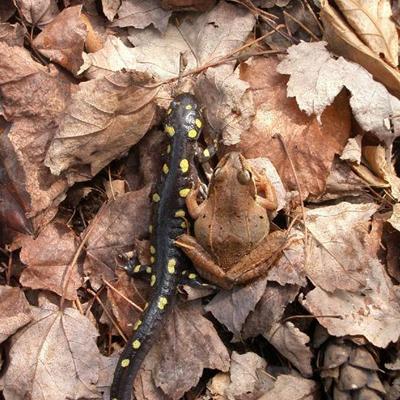Experimental Testing of Buffer Requirements for Amphibians Inhabiting Vernal Pools in Forested Landscapes

Forest amphibians rely on both vernal pools and surrounding upland habitat to complete life cycles. Protection of vernal pools from timber harvesting largely depends on recently developed Best Management Practices that advocate for terrestrial buffer zones around these habitats. To examine response of amphibians to terrestrial buffer management, NSRC researchers studied effects of buffer zone size on amphibian movement and demographics in Maine.
Thirty-meter and 100-meter wide buffers of intact forest surrounding vernal pools were, in turn, surrounded by 100-meter wide clearcuts. Researchers encircled vernal pools with drift fences and pitfall traps to capture amphibians entering and exiting. They also radio tracked wood frog and spotted salamander movement. Demographic responses were highly variable, but body condition of amphibians at wetlands with the 30-meter wide buffers was lower than from sites with no cutting.
Amphibians entered and left wetlands in variable directions across years and among species suggesting that corridor approaches to protection may not work best in this landscape. Wood frogs and spotted salamanders moved up to 428 and 350 meters from breeding ponds, respectively. Wood frogs crossed but did not use clearcuts as summer/fall habitat, although frogs at 100-meter buffer sites were more likely to stay in the buffer than cross the cut. Salamanders only crossed cuts during a wet year and used mammal burrows extensively. One hundred meter wide clearcuts appear crossable, so response of amphibians to buffer treatment is partly due to width of the cuts. Research on response to wider cuts is necessary to fully understand the connection between upland habitat and population viability.
Download printable version [PDF]
Download full final report [PDF]
